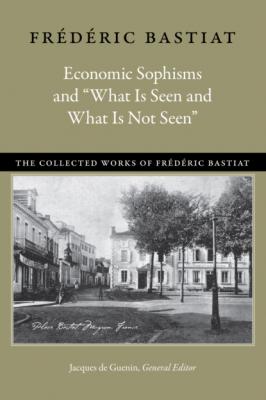Economic Sophisms and “What Is Seen and What Is Not Seen”. Bastiat Frédéric
Читать онлайн.| Название | Economic Sophisms and “What Is Seen and What Is Not Seen” |
|---|---|
| Автор произведения | Bastiat Frédéric |
| Жанр | Экономика |
| Серия | The Collected Works of Frederic Bastiat |
| Издательство | Экономика |
| Год выпуска | 0 |
| isbn | 9781614872740 |
A list of the works of Bastiat is available on the Online Library of Liberty website, http://oll.libertyfund.org/people/25. It is kept up to date as each volume is published.
[print edition page xlviii]
[print edition page xlix]
One man’s gain is another man’s loss.
—MONTAIGNE
Let me speak of a standard sophism, one that is the very root of a host of sophisms, one that is like a polyp which you can cut into a thousand pieces only to see it produce a thousand more sophisms, a sophism that offends alike against humanity, Christianity, and logic, a sophism that is a Pandora’s box from which have poured out all the ills of the human race, in the form of hatred, mistrust, jealousy, war, conquest, and oppression, and from which no hope can spring.
O you, Hercules, who strangled Cacus! You, Theseus, who killed the Minotaur! You, Apollo, who killed Python the serpent! I ask you all to lend me your strength, your club and your arrows, so that I can destroy the monster that has been arming men against one another for six thousand years!
Alas, there is no club capable of crushing a sophism. It is not given to arrows, nor even to bayonets, to pierce a proposition. All the cannons in Europe gathered at Waterloo could not eliminate an entrenched idea from the hearts of nations. No more could they efface an error. This task is reserved for the least weighty of all weapons, the very symbol of weightlessness, the pen.
—BASTIAT, “ONE MAN’S GAIN IS ANOTHER MAN’S LOSS” (ES3 15)
With his pen in hand, Frédéric Bastiat burst onto the Parisian political economy scene in October 1844 with the publication of his first major article, “De l’influence des tarifs français et anglais sur l’avenir des deux peuples” (On the Influence of French and English Tariffs on the Future of the Two Peoples)
[print edition page l]
in Le Journal des économistes.1 This proved to be a sensation, and he was welcomed with open arms by the Parisian political economists as one of their own. This was followed soon after by Bastiat’s first visit to Paris and then England in order to meet Richard Cobden and other leaders of the Anti–Corn Law League. Bastiat’s book Cobden and the League appeared in 1845. The book was Bastiat’s attempt to explain to the French people the meaning and significance of the Anti–Corn Law League by means of a lengthy introduction and his translation of key speeches and newspaper articles by members of the League.2
It was in this context that Bastiat wrote a series of articles explicitly called “Economic Sophisms” for the April, July, and October 1845 issues of Le Journal des économistes. These became the first half of what was to appear in January 1846 as Economic Sophisms (First Series). As articles continued to pour from Bastiat’s pen during 1846 and 1847 and were published in his own free-trade journal, Le Libre-échange (founded 29 November 1846 and closed 16 April 1848), and in Le Journal des économistes, he soon amassed enough material to publish a second volume of Economic Sophisms, called naturally enough, Economic Sophisms (Second Series), in January 1848, just one month before the outbreak of the 1848 Revolution in Paris. As Bastiat’s literary executor and friend Prosper Paillottet noted in a footnote in the Œuvres complètes, which he edited, there was even enough material for a third series compiled from the short articles which had appeared between 1846 and 1848 in various organs such as Le Libre-échange, had Bastiat lived long enough to get them ready for publication. We have included this material in this volume as Economic Sophisms “Third Series.”
Thus, with Liberty Fund’s edition of Bastiat’s Collected Works we have been able to do what he and Paillottet were not able to do, namely, gather in one volume all seventy-five of Bastiat’s actual and possible Economic Sophisms. The selection criteria for the additional material were similarity to the other sophisms in style (short, witty, sarcastic, sometimes in dialog form) and in seeking to debunk widely held but false economic ideas (or “fallacies” or “sophisms”). We also include in this volume the pamphlet What Is Seen and What Is Not Seen, which
